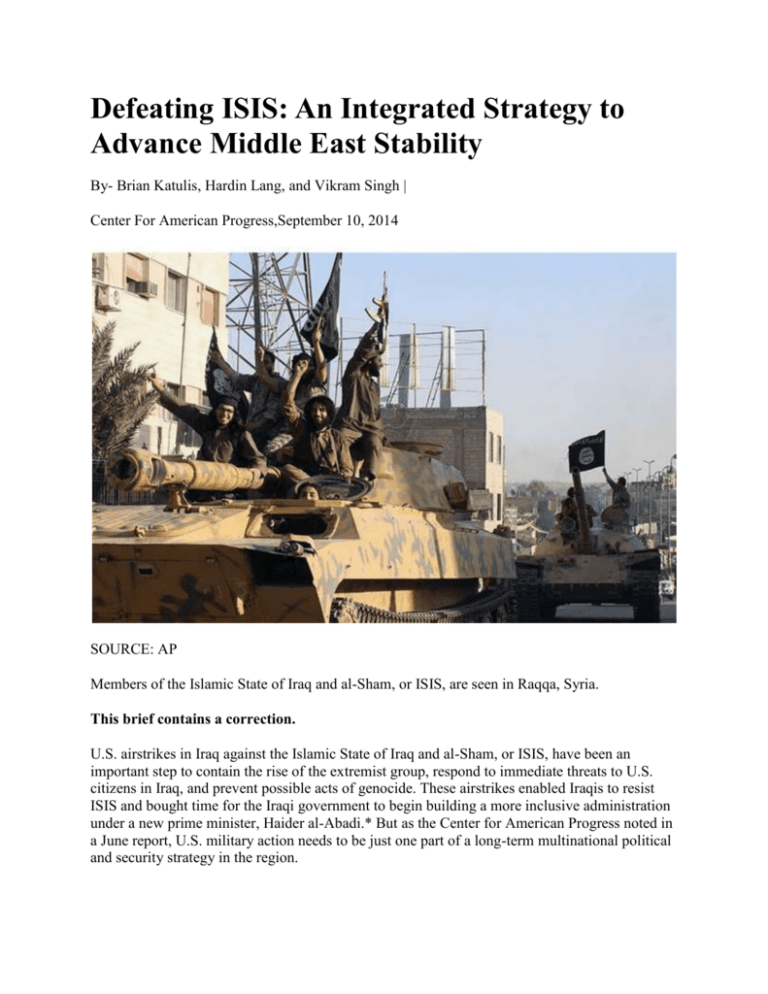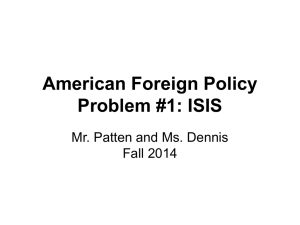Defeating ISIS: An Integrated Strategy to Advance Middle East Stability
advertisement

Defeating ISIS: An Integrated Strategy to Advance Middle East Stability By- Brian Katulis, Hardin Lang, and Vikram Singh | Center For American Progress,September 10, 2014 SOURCE: AP Members of the Islamic State of Iraq and al-Sham, or ISIS, are seen in Raqqa, Syria. This brief contains a correction. U.S. airstrikes in Iraq against the Islamic State of Iraq and al-Sham, or ISIS, have been an important step to contain the rise of the extremist group, respond to immediate threats to U.S. citizens in Iraq, and prevent possible acts of genocide. These airstrikes enabled Iraqis to resist ISIS and bought time for the Iraqi government to begin building a more inclusive administration under a new prime minister, Haider al-Abadi.* But as the Center for American Progress noted in a June report, U.S. military action needs to be just one part of a long-term multinational political and security strategy in the region. The new strategy should aim to contain and degrade ISIS and enable regional partners to continue to build the tools needed to defeat ISIS’s movement with international support. This report outlines actions to advance three core strategic goals: 1. Contain and degrade the threat ISIS poses to the Middle East region and global security 2. Alleviate the humanitarian crisis affecting millions of Syrians and Iraqis 3. Restore the territorial integrity of Iraq and Syria The ISIS threat is eroding the borders of both Iraq and Syria, and it represents an immediate and significant threat to the surrounding region. ISIS also represents an evolving threat to the United States, Europe, and global security in the form of international terrorism enabled by the group’s thousands of foreign fighters and its abundance of cash and military resources. An environment of chaos and great suffering has allowed ISIS to emerge. The conflict in Syria alone has created the largest humanitarian crisis the world has faced in decades. Some 9 million Syrians have fled their homes, and 3 million Syrians are now refugees, making them the world’s largest refugee population and placing a tremendous burden on neighboring countries, such as Jordan, Lebanon, and Turkey. As with efforts to counter extremism elsewhere, defeating ISIS will require a concentrated effort over time. Any successful U.S. strategy must be built on a foundation of regional cooperation that requires coordinated action from U.S. partners—a central concept of the Counterterrorism Partnership Fund that President Barack Obama proposed earlier this year. The strategy will be multifaceted, involving intelligence cooperation, security support, vigorous regional and international diplomacy, strategic communications and public diplomacy, and political engagement. While military action alone will be insufficient to defeat ISIS, the United States and other nations may need to undertake airstrikes and provide military assistance to disrupt and degrade ISIS in Syria. These strikes should be conducted in concert with regional and international partners. Ideally, such airstrikes would receive the support from the United Nations or—absent action to authorize the use of force by the U.N. Security Council—from a coalition of America’s Gulf partners and North Atlantic Treaty Organization, or NATO, allies. As always, the United States should reserve the right to undertake unilateral military action to defend the homeland or protect U.S. personnel from imminent harm. Whether unilaterally or with partners, U.S. military strikes should be limited in terms of scope and duration and under clear oversight of Congress. As CAP said in June when it advocated for action against ISIS in Iraq, “The United States should not undertake military action lightly and should be wary of unintended consequences. But not all military action is the same. Ground troops or invasions to control a country are very different from limited air strikes or targeted assistance to help push back terrorist extremists.” Focusing too much on direct U.S. military action in the fight against ISIS ignores the equally important diplomatic and economic steps that will be required to defeat this extremist group. U.S. military strikes or even boots on the ground cannot defeat ISIS alone and could become a rallying cry and recruitment tool for extremists, repeating one of the most costly strategic errors of the 2003 Iraq War. At the same time, building a unified, committed coalition to effectively degrade ISIS will require intense diplomatic and military leadership from the United States to mobilize and coordinate partners. The United States must leverage its unique capabilities in the military, security assistance, and intelligence arenas. Working together, nations committed to defeating ISIS should take concerted action to empower regional and local forces to fight back against ISIS terrorism. A successful U.S. strategy will require reinvigorated support for Syrian opposition forces to establish a third way that is opposed to President Bashar al-Assad’s regime on one side and ISIS on the other. This reinvigorated support should include the $500 million of additional assistance that President Obama proposed in June. With 10 nations agreeing to work together against ISIS during the NATO summit in Wales and the Arab League announcing a joint commitment to fight ISIS, the foundation for such international cooperation is taking shape. These countries— including the United Kingdom, Germany, Turkey, Saudi Arabia, and the United Arab Emirates—should match their commitment on paper with financial and material resources to complement the resources committed by the United States in the fight against ISIS. An integrated strategy to degrade and defeat ISIS and advance stability in the Middle East ISIS’s advances this summer have made Iraq and Syria part of the same battlefield, erasing the international border and turning the regional struggles for power into a substantial threat to international peace and security. The United States should advance its three core goals noted above by focusing on the following pillars: Building and managing an international coalition to defeat ISIS and stabilize the region Increasing support for Iraq’s political, economic, and security transitions, in particular with a revived U.S.-Iraq Strategic Framework Agreement Initiating a more concerted effort to end Syria’s civil war and support the creation of a transitional government Pillar I: Building and managing coalitions to defeat ISIS and stabilize the region The United States should not confront the threat posed by ISIS alone. The international and regional coalition against ISIS should look more like the 1991 Gulf War or the post-9/11 coalition against Al Qaeda and the Taliban and less like the 2003 Iraq War coalition. Secretary of State John Kerry’s and U.S. Defense Secretary Chuck Hagel’s visits to the region to press for coordinated action are a good start. To follow up, the United States should designate a specific U.S. government lead or a small interagency team to manage the building and sustaining of an anti-ISIS coalition. There is no playbook for this sort of effort, and the United States should operate on three levels: with actors in the region, with transatlantic partners and other core allies, and through the United Nations. Regional cooperation The United States should propose that states in the region commit to common principles and specific, coordinated actions to help isolate and counter ISIS and better respond to the humanitarian catastrophe. This will not be easy as the Sunni-Shia sectarian divide in the region is now accompanied by growing tensions between leading Sunni-majority states. In addition, key countries in the region lack some basic capacities needed for operational impact, as demonstrated by the failure of regional efforts to support elements of the anti-Assad opposition in Syria. While the United States and other countries may need to fill such capability gaps, regional partners should contribute financial and other resources to support a multinational effort. With partners in the region, the United States can take the following steps: Create an ISIS-focused intelligence fusion cell in the region. The United States has a wide range of networked relationships with key Middle East intelligence services. Jordan is a close partner in counterterrorism efforts throughout the Middle East and outside the region in places such as Afghanistan. Saudi intelligence services have been battling certain Islamist extremist groups, such as ISIS and al-Nusra Front—the Al Qaeda affiliate now dominating parts of the battlefield. The Turkish National Intelligence Organization also has extensive intelligence contacts and specialized knowledge of the various extremist groups operating in northern Syria. The United States would need to provide the backbone for any regional intelligence fusion effort. Establish a multi-agency and multinational ISIS threat finance cell to target the economic base of ISIS. ISIS funds its activities from areas under its control through taxation, illicit economies such as oil smuggling and extortion, and external support, mainly from individuals in Gulf states. Some estimates project ISIS will raise between $100 million and $200 million over the next year. To disrupt ISIS’s finances, the United States should work with regional partners to target the criminal networks that ISIS uses to sell goods or otherwise generate revenue; disrupt ISIS oil extraction, transport, and refining operations and prevent exchanges with buyers in foreign markets such as Iran, Turkey, and the Kurdistan Regional Government, or KRG; and disrupt online and regional fundraising efforts. The United States should create an interagency threat finance cell headed by either the U.S. Treasury Department or State Department with military and intelligence personnel, and it should be based in the region to help coordinate the collection and analysis of financial and economic intelligence. Coordinate security assistance to national and subnational actors fighting ISIS and al-Nusra Front on the ground in Syria and Iraq. The United States has already stepped up its direct military assistance to Iraqi Kurdish forces and has proposed an additional $500 million to support select members of the Syrian opposition. These efforts should be incorporated into a regional plan. In many instances, the most capable security partners will likely be found at the subnational level, including tribes, and U.S partners in the region will have deeper ties and greater ability to provide support to such forces fighting ISIS. A joint State Department and Defense Department team should coordinate these efforts. Airstrikes and surveillance in support of regional forces and local ground forces fighting ISIS and al-Nusra Front. In targeted instances, the United States—and if possible, a broader coalition of allies—should conduct direct military airstrikes against ISIS and other radical groups operating in Syria and Iraq. These strikes should be conducted as part of a regional or international coalition under a multilateral framework with congressional authorization and oversight. A transatlantic and allied response to ISIS The September 2014 NATO summit took several steps to energize the transatlantic community to confront ISIS. Nine countries pledged to join U.S. efforts to counter ISIS, but no specific commitments were made. And as evidenced over the past few years in Afghanistan and Libya, follow through on commitments is essential. Further, the United States and its Western partners need to proactively manage the dangers posed by European and American citizens now fighting alongside ISIS. The United States should work with its transatlantic partners and traditional allies to: Enable reliable and capable partners in the region to take the fight directly to ISIS. The United States is providing the greatest support to forces fighting ISIS. NATO and other U.S. allies should together develop a strategy to help the region counter ISIS with technical support and military assistance. This should include specific commitments to provide support to the Iraqi government, Kurdish forces, and third-way opposition alternatives to the Assad regime and ISIS in Syria. Enhance law enforcement and intelligence fusion efforts to identify and counter ISIS and other terrorist fighters holding Western passports. This should build on existing U.S.-European efforts in coordination with the International Criminal Police Organization, or INTERPOL. More than 12,000 foreign fighters are estimated to have flocked to Iraq and Syria. According to intelligence agencies and outside experts, onequarter of these fighters come from Western countries. With an estimated 3,000 individuals, including perhaps 500 each from Britain and France, the dangers of extremists coming home to continue the fight with acts of terrorism cannot be ignored. Western countries should partner with allies in the Middle East and local communities on counter-radicalization efforts. Engagement at the United Nations The Obama administration has taken important steps to build international mechanisms on counterterrorism and should expand efforts at the United Nations during the upcoming U.N. General Assembly. This summer, the U.N. Security Council voted to add ISIS members to the Al Qaeda sanctions regime and invoked Chapter VII of the U.N. Charter, underscoring the threat that ISIS poses to international peace and security. This can serve as a useful basis for coordinating international action to disrupt ISIS’s financing and other support. Given the divisions among leading global powers, action through the United Nations to authorize the use of force against ISIS, particularly in Syria, would prove difficult. Nonetheless, engagement through the United Nations can build political capital and legitimacy for unified international action against ISIS, including military strikes should they prove necessary. As part of this effort, the United States should: Seek passage of a new U.N. Security Council resolution on foreign terrorist fighters. The U.N. Security Council meeting that President Obama will personally chair later this month offers a unique opportunity to mobilize international action on the foreign terrorist fighter issue. A new U.N. Security Council resolution, or UNSCR, could sharpen countries’ tools to counter radicalization and to meet their obligations to suppress terrorism and prevent terrorist recruitment. President Obama can stress that a new resolution should increase cooperation between various counterterrorism and lawenforcement bodies, helping frontline states track and coordinate with entities such as INTERPOL. Urge the appointment of a U.N. special envoy to lead the international response to the regional humanitarian crisis and step up assistance for displaced Syrians and Iraqis. During the U.N. General Assembly, the United States should support funding for United Nations’ existing appeals for refugees in the region. U.S. leaders should call on U.N. Secretary General Ban ki-Moon to appoint a high-profile U.N. envoy to lead multilateral and bilateral relief efforts. This would not be a political position but rather modeled on the East Asia tsunami and Haiti earthquake relief efforts and focused on rallying global support for people affected by conflict and displaced throughout the region. Encourage planning for a possible peacekeeping or stabilization mission. The United States should begin discussions in the U.N. Security Council about planning for international peacekeepers in parts of Syria and perhaps Iraq after stability is restored. The mission could be modeled on the U.N. Interim Force in Lebanon, or UNIFIL, and draw on the lessons of a new generation of peacekeeping operations currently underway in Mali and the Democratic Republic of Congo. Pillar II: Increasing support for Iraq The Obama administration has established a coherent framework for dealing with the security threats posed by ISIS in Iraq and for advancing long-term stability in the country. With a new, inclusive Iraqi government in place, there are several key actions the United States should take in the coming months on Iraq, including: Political and diplomatic engagement Re-engage the Iraqi government on an enduring U.S.-Iraqi Strategic Framework Agreement. A comprehensive agreement between the U.S. and Iraqi governments that outlines broad areas of cooperation in the bilateral relationship will be crucial to any long-term effort to support the Iraqi government in re-establishing security in the country and countering extremist groups such as ISIS. Continue to condition U.S. military support on inclusive governance and Sunni outreach. The successful formation of a power-sharing government in Iraq on September 8 may allow the United States to provide greater security assistance to Iraq. Military action without effective Sunni outreach risks increasing support for ISIS and further inflaming the Sunni community. The United States should continue to offer support for a new, inclusive government under Prime Minister Abadi and hold the new Iraqi government to a high standard of inclusion as a condition for ongoing support. Engage the Sunni tribes with our regional partners. The United States should work with our regional Sunni partners in Jordan and the Gulf states to undertake outreach to the Sunni tribes in western Iraq. Any effort to re-engineer a program similar to the Sons of Iraq program—the U.S. military-led effort to combat Al Qaeda in Iraq by partnering with local Sunni tribes—as part of Baghdad’s Sunni outreach can only be done effectively in cooperation with regional partners, particularly Saudi Arabia and Jordan. The United States should consider providing military and nonmilitary support to select tribes if they prove willing to take on ISIS. Security assistance Maintain conditional U.S. military support to the Iraqi Army. If political outreach bears fruit, the United States should provide a robust support package to help the Iraqi Army move against ISIS, including air support. The United States can help restructure Iraqi national security institutions and help them rebuild the diverse elements of the Iraqi security forces that were dismantled under former Prime Minister Nouri al-Maliki. This can include the recruitment of local units to secure Sunni areas. It should encourage a new Iraqi government to include Sunni and Kurdish members in the senior ranks of Iraq’s national security forces. Re-enforce the Kurdistan Regional Government. Bolster the Kurdish forces, known as the Peshmerga, to conduct limited offensive operations to force ISIS into a defensive position in northern Iraq. If Sunni outreach from Baghdad is forthcoming, the U.S. could support the Peshmerga in undertaking a coordinated campaign with the Iraqi Army. Direct U.S. military action Continue targeted strikes and intelligence, surveillance, and reconnaissance support. The United States should remain engaged with the Iraqi national security forces and other Iraqi forces such as the Peshmerga to target ISIS and re-establish control of Iraqi territory by legitimate Iraqi institutions. Pillar III: Confronting ISIS in Syria The imperative of removing President Assad from power must give way to the more immediate danger of ISIS sanctuary. This does not mean partnering with President Assad, who would likely continue to accommodate ISIS and other extremists in order to keep his regime alive. The United States will need to develop a shared understanding with Jordan, Lebanon, Turkey, and the members of the Gulf Cooperation Council that countering ISIS is the first priority as it takes the following steps: Support for local actors Strengthen the third-way Syrian opposition. The Obama administration proposed $500 million of additional assistance to the Syrian opposition in June. Congress should approve this request, and the United States should accelerate efforts to build up moderate opposition forces in Syria to combat ISIS. New assistance should be directed to those groups already receiving U.S. support, such as Harakat Hazm and the Syrian Revolutionaries’ Front. Although these armed moderates have limited capabilities, new assistance could help them slow ISIS’s advances and, over time, begin to reverse ISIS gains. The main short-term objective is to ensure that third-way anti-Assad and anti-ISIS forces survive. This effort will need to be coordinated with other regional partners that are able to support the armed opposition. Expand outreach to Sunni tribes in Syria. The United States should expand its outreach to include Sunni tribes as a means to limit ISIS’s influence. ISIS’s use of foreign fighters to govern will undercut the influence of the traditional tribal structure over time. The United States should establish common cause with Sunni tribal leaders and give those willing to stand against ISIS the support needed to provide for their constituents. Political transition Maintain the long-term objective of transition from the Assad regime in Syria. Efforts to strengthen the regional offensive against ISIS will not succeed if these actions are seen in the region as directly benefiting the Assad regime. The United States should continue to work with regional actors to explore and exploit fissures within the Assad government’s ruling elite. Such fissures could open up more viable pathways toward a political transition from President Assad. Rebuild the regional and international foundations to mediate a solution to the Syrian conflict. Although peace talks in Geneva failed in early 2014, the efforts outlined in this report—including increased support for third-way opposition alternatives to the Assad regime and ISIS—could set the conditions for a political transition in Syria. U.S. diplomats should work to reinvigorate a regional contact group on the Syrian conflict to start building a foundation for new peace talks. Ultimately, the conflict in Syria requires a political solution. Possible targeted airstrikes again ISIS Consider expanding airstrikes into Syria in coalition with Gulf partners and NATO. As in Iraq, airpower may be a critical element of disrupting ISIS in Syria and supporting the moderate opposition. Any strikes within Syria should be conducted in coalition with America’s Gulf partners and NATO allies, ideally with U.N. support. Airstrikes may be employed to support third-way opposition fighters as they take the fight to ISIS, as well as to defend these opposition fighters against attacks from Assad’s security forces. Robust intelligence collection should precede such strikes. The United States should, of course, reserve the right to undertake unilateral military action if the ISIS threat becomes imminent to the United States as has been the case with Al Qaeda in Yemen or alShabaab in Somalia. In light of what is likely to be sustained effort, President Obama and congressional leaders should cooperate to develop an appropriate authorization for military action against ISIS that can help pave the way to a durable framework for fighting terrorism. Conclusion ISIS control of large swaths of territory in Iraq and Syria poses a clear threat to American interests and to stability across the Middle East. If unchecked, ISIS’s brutality, growing capacity, and recruitment of foreign fighters can significantly increase the risks of international terrorism. The United States can meet this threat in coalition with its allies and partners, but all involved parties must be prepared to pull their weight. ISIS can only be defeated by determined action from an international and regional coalition in which a broad range of countries decide that enough is enough and commit to a joint effort. U.S. leadership and engagement will be essential to the success of such an effort, which represents an opportunity to help bring greater stability to the region as a whole. Brian Katulis and Hardin Lang are Senior Fellows with the National Security and International Policy team at the Center for American Progress. Vikram Singh is the Vice President for National Security and International Policy. *Correction, September 10, 2014: This brief has been corrected to reflect that U.S. airstrikes have enabled different segments of Iraq society to resist ISIS.







